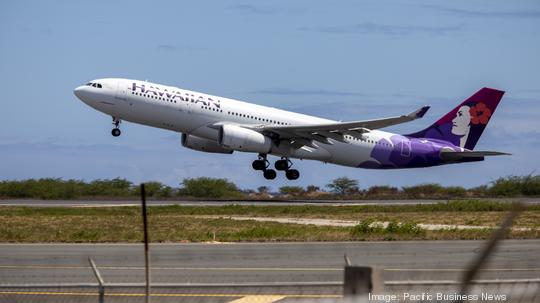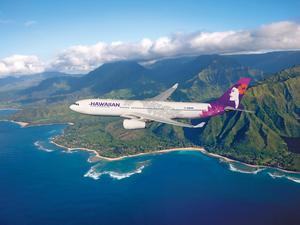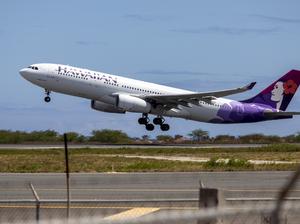
Hawaiian Airlines says it plans to eliminate single-use plastics in its cabins by 2029 and source more in-flight food and beverage items from local producers.
The airline outlined the commitments in its annual Corporate Kuleana Report for 2022 released last week. The report provided updates on some of its environmental, social and governance goals, and identified new priorities surrounding sustainability and food independence.
“We’ve had for a while the commitment to get to net zero carbon emissions by 2050, which is a broad industry-wide commitment," Avi Mannis, chief marketing and communications officer at Hawaiian Airlines, told Pacific Business News. "We’ve added on top of that some of these very specific product commitments around eliminating single-use plastics and buying more locally and doing more humane sourcing.
“We think [these goals] are going to challenge our team to innovate and find new solutions to these problems so we can be a better airline.”
PBN recently chatted with Mannis about these commitments and how the airline is working to accomplish them.
On eliminating single-use plastics…
Mannis said that the company doesn’t yet know exactly how it will reach the 100% elimination benchmark — which begins with the initial goal of cutting 50% of its plastic pollution by 2025 — but he said efforts are underway to figure out solutions.
The first step, Mannis said, is to identify and evaluate the use of such items in the airline’s daily operations. As they go about this, he admitted they’re finding “lots and lots” of single-use plastics — plastic water bottles, of course, but also everything from beverage stir straws to packaging for blankets.
“When you start to go through it item by item, it’s really an exciting challenge, but it’s daunting because there is so much plastic,” he said. “Each of those items is something that we have to think through first whether or not we really need it — and then if we do need it, how we replace it with something more sustainable.”
Some of this work has already been done. For instance, the airline has replaced plastic beverage stirrers with an alternative made from bamboo, and swapped certain plastic cups with a compostable version.
The company also recently launched a partnership with Mananalu, an aluminum water bottle company founded by Hawaii-born actor Jason Momoa.
Mananalu bottles will replace plastic bottles for premium cabin guests on all U.S. East Coast and international flights, as well as on the snack cart on flights between Hawaii and its 16 Mainland gateway cities. Hawaiian estimates that it will eliminate 142,000 plastic bottles from its operations each year through the partnership.
When asked what eliminating single-use plastics will mean for the airline’s operational expenses, Mannis said that “we are committed to getting to this goal and there are some costs we will be willing to accept to do that.”
“But hopefully over time, we will also eliminate waste from the process and find savings by designing our products better than we do today.”
On local sourcing…
Buying local is something that the airline has been working on for the past few years, and it currently sources 29% of its food and beverage products for Hawaii-based catering from local companies. Product partners include Maui Brewing Co., Hawaiian Chip Company, and La Tour.
“This has been something that is very important to us both to help the local economy and also to avoid having to ship in products from other places, which has a carbon footprint associated with it,” Mannis said.
“Our challenge to ourselves now is how we take it from 30% percent — which is about $5 million a year that we are spending on local products — to 40% percent, which adds another $2 million a year or so.”
The airline aims to reach the 40% mark by 2025. Mannis noted that that doesn’t necessarily mean an additional $2 million in expenditures, but that the airline will shift its spending to include more products that are procured locally.
He said the airline also plans to try to incorporate more locally grown produce into menu items.
“We think this is a great opportunity for us as a business that’s invested in tourism here to also help diversify the economy and build food security in our community,” he said.
This marks Hawaiian Airlines’ third annual Corporate Kuleana Report. Mannis noted that other highlights in this year’s report include updates on the company’s efforts toward net-zero carbon emissions, sustainable tourism initiatives and employee volunteer work. For the full report, click here.






